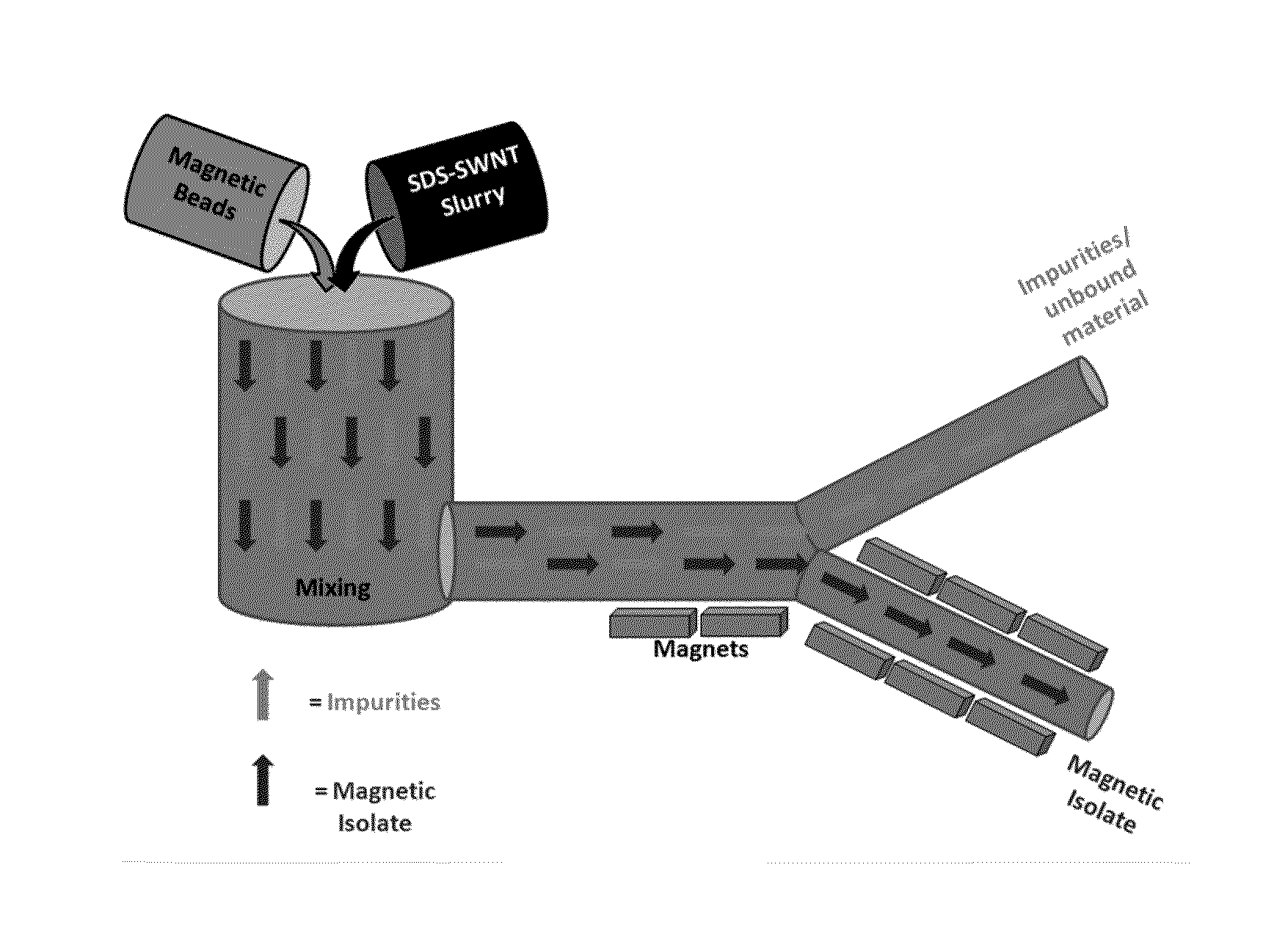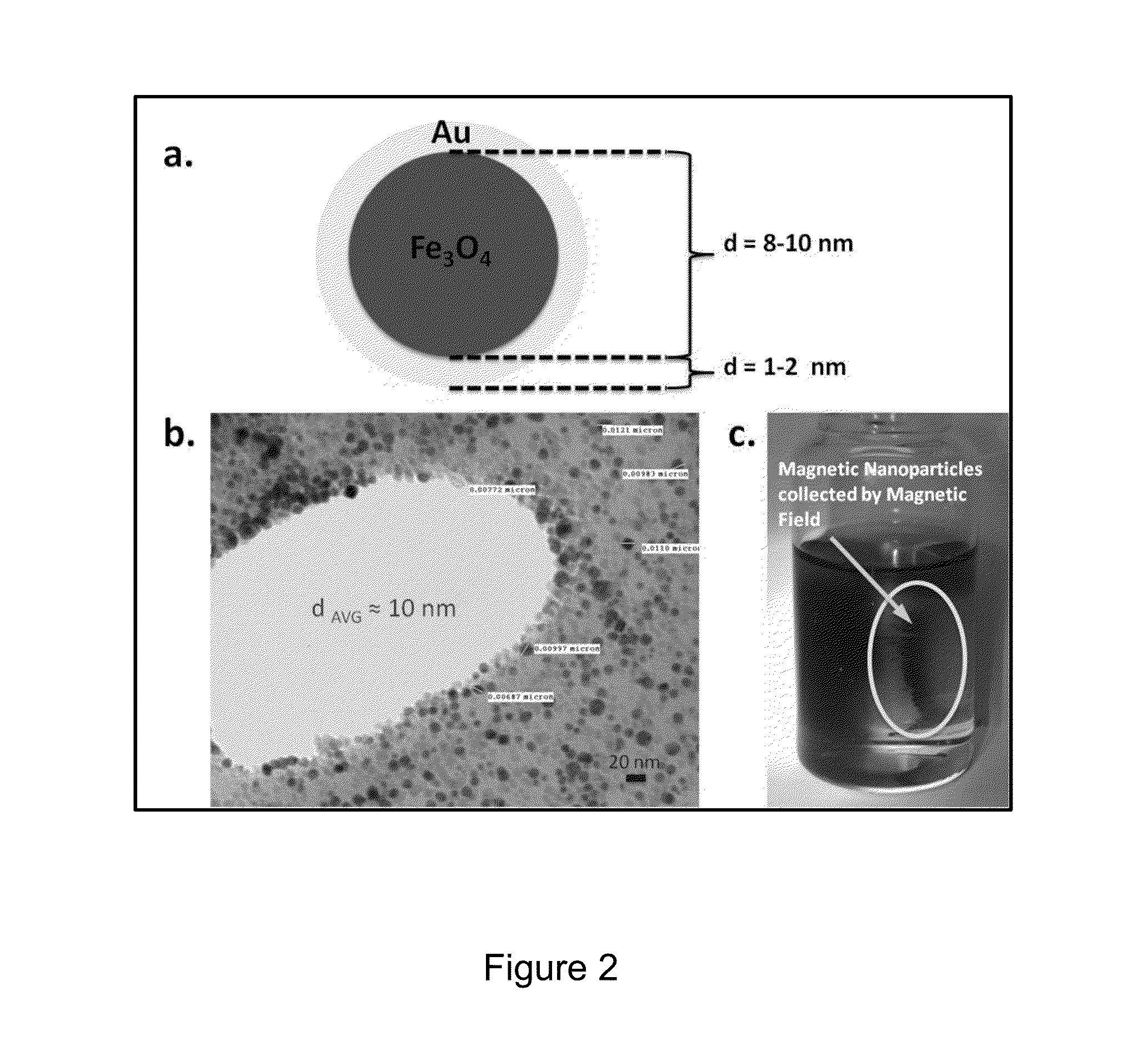Compositions, methods, and systems for separating carbon-based nanostructures
- Summary
- Abstract
- Description
- Claims
- Application Information
AI Technical Summary
Benefits of technology
Problems solved by technology
Method used
Image
Examples
examples
[0080]Owing to their exceptional characteristics, carbon nanomaterials are highly sought after for applications including electronics, antennas, energy harvesting and storage, chemical and biological sensing, bio-imaging and medical treatment. Their performance in these applications largely depends on their electronic, optical and physical characteristics. As such, developing methods with which homogenous materials can be isolated is an important and active area of research.
[0081]This example presents an approach towards single walled carbon nanotube separation that makes use of several features, including, but not limited to:
1) A magnetic nanoparticle or collection of nanoparticles embedded into a matrix (e.g., microparticles) that also serves as an adsorbent for the carbon-based nanostructures.
2) The adsorbent which may demonstrate a high affinity towards one particular carbon-based nanostructure (e.g., metallic, semiconducting or specific (n,m) metallic or semiconducting SWNT). T...
example 2
[0119]This examples describes a non-limiting embodiment of magnetic bead synthesis. This synthesis may be scaled up. See FIG. 3b.
Procedure:
[0120]1. Sephacryl generally is provided in ethanol (EtOH). Thoroughly washed with nanopure water (NP H2O), allowing 4 fold excess to run through 100 ml sephacryl suspensions in a column.[0121]2. After thoroughly washing sepahcryl, placed in 500 ml roundbottom flask with at least 2 necks and added FeCl3.6(H2O), FeCl2.4(H2O), NP H2O and stir bar.[0122]3. Sealed contents with stoppers and reflux condenser, also equipped with a rubber stopper,
MaterialsAmountSephacryl HR S-20050mlFeCl3•6(H2O)0.25gFeCl2•4(H2O)0.088gAmmonia Solution 27% in H2O (NH4OH, NH3•H2O)15mlNP H2O50mlN2 (UHP) and pumped N2 into sealed container ˜15-30 min so that all air is replaced by N2 under vigorous stirring.[0123]4. Removed N2 inlet and outlet and heated from room temperature to 80° C. over ˜15 min, then allowed to equilibrate for ˜15 min @ 80° C. under reflux.[0124]5. Rapi...
example 3
[0127]This examples describes a non-limiting embodiment of non-ultracentrifugation based purification of a mixture of carbon-based nanostructures. See FIG. 12.
Procedure:
[0128]1. Made stock of sodium dodecyl sulfate suspended single walled carbon nanotubes (SDS-SWNT), using 1 mg / ml SWNT suspended in 1 wt % SDS in NP H2O using ultrasonication (checked UV-VIS to ensure a good dispersion).[0129]2. Washed Magnetic Beads with 4 fold volumetric (vol) excess of 2 wt % SDS in NP H2O.[0130]3. Placed 1:1 vol magnetic beads: SDS-SWNT in a vial and thoroughly mixed for ˜12-24 hours to ensure appropriate equilibration[0131]4. Placed vial next to neodymium magnet (Brmax=0.5 Tesla) and allowed magnetic beads to be isolated on the side of the container.[0132]5. Pipetted off / decanted off “supernatant” material and stored as “supernatant” (this material generally shows some enrichment in m-SWNT, but should mostly contain
MaterialsAmountSephacryl HR S-200100mlFeCl3•6(H2O)1gFeCl2•4(H2O)0.352gAmmonia Solu...
PUM
 Login to View More
Login to View More Abstract
Description
Claims
Application Information
 Login to View More
Login to View More - R&D Engineer
- R&D Manager
- IP Professional
- Industry Leading Data Capabilities
- Powerful AI technology
- Patent DNA Extraction
Browse by: Latest US Patents, China's latest patents, Technical Efficacy Thesaurus, Application Domain, Technology Topic, Popular Technical Reports.
© 2024 PatSnap. All rights reserved.Legal|Privacy policy|Modern Slavery Act Transparency Statement|Sitemap|About US| Contact US: help@patsnap.com










